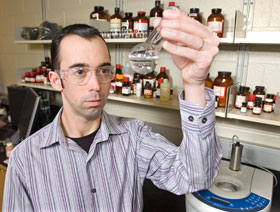  |
| HOME | THIS ISSUE | CALENDAR | GRANTS | BACK ISSUES | < BACK | NEXT > |
Chemists using microwave energy to speed chemical reactionsby Scott Brinckerhoff - March 26, 2007 | ||||
| Decades ago, microwave ovens opened up new worlds for cooks everywhere. Now they’re doing the same thing for chemists at UConn.
The UConn chemistry department is at the forefront of research into ways microwave energy can speed up chemical reactions and change the way biofuels, medicines, and other products are made. “In the past year, we’ve been making biodiesel fuel in the microwave, using vegetable oil and methanol,” says Nicholas Leadbeater, an assistant professor of chemistry. “We now have a system that lets us make up to 111 gallons an hour, cleanly and easily.” The fuel that Leadbeater and his colleagues are making could be burned in a diesel automobile engine or a home oil heat system. The UConn laboratory is also making it in a much smaller space than a traditional biodiesel reactor would require. “What we’ve done here could translate into real benefits in daily life,” Leadbeater says. “For example, McDonald’s could heat their restaurants with used french fry oil transformed into biofuel on site, using microwave technology.” The biodiesel advances are impressive, but they’re only one of several areas that Leadbeater and his team – four graduate students, one post-doctoral student, and six undergraduates – are pursuing. Pharmaceuticals and electronics, for example, may benefit from what the team is learning about a process called the Suzuki reaction. Leadbeater explains that the molecular structure of many drugs requires that two carbon rings be joined together using the Suzuki reaction, named for the person who invented it. As done today, the reaction can take many hours, a great deal of metal catalyst, and toxic solvents. But with the microwave, the process is complete in a few minutes, using water as a solvent and only tiny amounts of the catalyst. The challenge with using microwaves as a production tool is that they don’t penetrate very deeply into a vessel. So it can be difficult to make large amounts of a product. However, the flow method devised for the biodiesel experiment works well, and the team is now looking at how a similar method might be used to produce the Suzuki reaction on a large scale. In the kitchen or the lab, microwaves offer an inexpensive and quick way to heat vessels and their contents. The UConn microwaves, however, bear only a passing resemblance to the $150 models at a retail store, other than the fact that they also “ping” when they have completed their task. UConn’s eight precision machines can cost anywhere from $10,000 to more than $200,000, depending on their capabilities. The first microwaves began showing up in chemistry labs in the late 1980’s, but they were conventional kitchen models. Results were often quite literally spotty, as samples exploded and even blew off oven doors. That changed with the advent of the precision oven – or “scientific microwave apparatus,” in chemists’ parlance – that heats uniformly and safely and even stirs samples. The UConn microwave chemistry facility is among the best-equipped in the United States, Leadbeater says. “We’re at the cutting edge of what you can do in a microwave,” he says. “Our research gets noticed by industry and other institutions, and they then try to carry it forward.” Leadbeater is not the only faculty member using microwaves in research; Professor Steve Suib, head of the chemistry department, is using them to make interesting inorganic materials. Leadbeater says his interest in microwaves goes back to 2000, when he visited a pharmaceutical company and saw how they were being used there. He began reading up on the subject and decided microwave chemistry could improve many processes. He also realized that a faster process may also turn out to be a less expensive one, in both development and production phases. In developing a new drug, for example, a chemist does not have to wait hours to see the results of an experiment that may not have been successful. Leadbeater says microwave chemistry may well help consumers save money on drugs, biofuels, and other materials. As a self-described eco-warrior, Leadbeater also likes the idea that microwaves support “green” chemistry, since water can often replace a toxic solvent. Microwave ovens have been embraced by cooks for decades, but they are only beginning to be accepted by chemists in academia and industry, despite clear evidence that they can greatly accelerate the time it takes for a desired reaction to occur. Leadbeater says the reluctance of some chemists to jump on the microwave bandwagon may simply be because tried and true methods of heating – convection and conduction – have long been used successfully, so why change? “The chemistry community can be conservative,” he says, “so we’ve come up with a motto, ‘Get a life – get a microwave.’” |
| ADVANCE HOME UCONN HOME |

